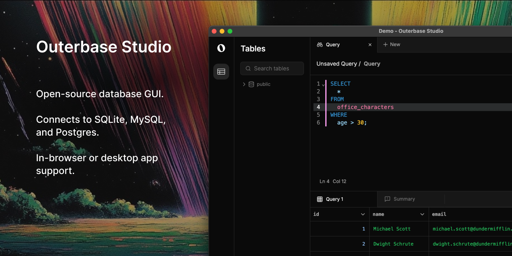Sick. I’ve tried a few times in the past to find a frontend for postgres that I liked, and was never able to. Will have to give this a try.
Same.
Only thing is, when I run it the postgresql driver is ‘invalid’. But I’m trying with an older version, like this:
docker run --rm -it --name outerbase --network host -h outerbase.local chewcw/outerbase-studio:v0.9.2
DBeaver is a bit clunky, but just too god to replace
Yeah, DBeaver used to be unusable, but it is quite decent these days. I was really unhappy with Datagrip, so I decided to give it another try and I am glad I did.
As far as this tool goes, I don’t love the idea of having my tools in the browser, so this won’t work for me, but it is a cool project nonetheless.
Here’s an official announcement: https://www.outerbase.com/blog/were-joining-cloudflare/
we are very excited about being part of the Claudflair team
Guess they’re so excited (and thrilled) that they forgot how to spell
in this way that makes you feel natural
The whole post needs a proofreader since it’s full of errors.
I’m getting flashbacks to phpmyadmin.
How does it compare to Adminer?
It looks like outerbase studio is primarily written in typescript where adminer is php.
Was that an answer from ChatGPT?
i’m sorry Dave, i’m afraid i can’t do that.
or to chartDB
If anyone got this running in docker for example, I like to hear from you ;)
Looks like it is provided here.
It’s an electron app that runs from the browser. Why would need it to run via docker?
Ok, I updated my drawing, so the arrows are correct:
┌─────────────────────────────────────────────────────────────────┐ │ Browser │ └─────────────────────────────────────────────────────────────────┘ ▲ │ :443 │ :80 ▼ ┌────────────────────────────────────────────────────────────────┐ │ Proxy (traefik) │ └────────────────────────────────────────────────────────────────┘ ▲ ▲ ▲ │ │ │ │ :3000 │ :8085 │ :5001 │ │ │ ▼ ▼ ▼ ┌───────────────────────┐ ┌────────────────┐ ┌────────────────┐ │ DBgate (in docker) │ │ pgBackupWeb │ │ My custom app │ └───────────────────────┘ └────────────────┘ └────────────────┘ ▲ ▲ ▲ │ :5432 │ :5432 │ :5432 │ │ │ ▼ ▼ ▼ ┌────────────────────────────────────────────────────────────────┐ │ Database │ └────────────────────────────────────────────────────────────────┘DbGate is connecting to my postgresql db. If I kill the container the communication is cut off. The ports 3000, 8089, 5001, 5432 are not open. How does DbGate load my postgres data then, if no backend? Sometimes I use it when my client messes up something thats only repairable in the db. Thats the exact scenario where its useful to run it in docker.
It’s right in their docs
Where? The app runs in the browser, but the data is still remote (from the pov of the browser)
Again, no.
DBGate is an application running in your browser. Just like any other desktop application, except it’s code is executed in the browser, and not a standalone window. DBGate uses the runtime platform of your browser to execute code and create connections to the database you’re using. That’s where you’re getting confused. There is nothing running in the docker container except a dumb HTTP server that allows your browser to load the code to executed, just as if you had visited their website.
This same exact code can also be packaged to run in Electron as a standalone window in your desktop so it seems like its own app. Same exact code that runs in your browser, but using Electron to host and execute its code.
Show me the docs. It really sounds like you’re confidentially incorrect :-)
The app part is indeed just running in the browser. But it needs the data over an external connection. Explain how it can read/write the data to me.
I…don’t think I need to. It’s all open source. Here is the DBGate repo right here.
If you’re unfamiliar with all of this, that’s your job to get educated. This is how browser-based JS software works. The “proof” is right there in all it’s glory for you to peruse.
I…don’t think I need to.
You dont need to indeed, but since you mentioned them first.
If you’re unfamiliar with all of this, that’s your job to get educated.
I’m a software engineer from way before the js hype, so I think I’m properly educated thanks.
The “proof” is right there in all it’s glory for you to peruse.
Indeed, here is the api part: https://github.com/dbgate/dbgate/tree/master/packages/api
That is a LOCAL running interface. It’s not something being run as a server-side interface in the docker container.
I’m not sure what point you’re trying to make, but at this point, you’re original concern and question has been answered.
If you’re unfamiliar with all of this, that’s your job to get educated. This is how browser-based JS software works.
The browser version cannot connect to Postgres without a server-side part, for rather obvious reasons - you can’t just make arbitrary network connections from the browser. Electron build is of course different, as that doesn’t have to deal with the browser sandbox.
By the way, here’s a similar issue documented in Outerbase’s repo:
Outerbase Studio Desktop is a lightweight Electron wrapper for the Outerbase Studio web version. It enables support for drivers that aren’t feasible in a browser environment, such as MySQL and PostgreSQL.
Not gonna lie, telling people how they need to get educated on stuff you don’t understand ticks me off.
Not gonna lie, telling people how they need to get educated on stuff you don’t understand ticks me off.
Thanks for backing me up. The fediverse needs to grow because this way it allows for people to be spout nonsense without being corrected by peers.
Btw, had outerbase running trough docker, but could not figure out a way to connect to my own pSql yet…
I don’t even know where to begin with this 😂
You had better alert the Internet at large and the developers of the apps being discussed here to let them that the very product they build is impossible then.
Oh…wait: https://reintech.io/blog/using-node-js-to-access-remote-database
A very basic example on how to do the very thing you said is not possible you say? While you’re at it, you better go alert Zoom, Google, Microsoft, and anyone else with a WebRTC app that they aren’t allowed to make connections to other things from the browser. It’s totally against the rules and impossible.
🤣
An electron app still needs to be served by a web server, even if the actual business logic is all client-sideEDIT: Electron, not React…
No? This is a client-side electron app. You’d need something to load the initial files, but that’s it. There are no server-side running parts. Even still, there’s links in the project here to load up the app right there. Each Major browser has ways to “install” such apps from there.
Well, I assume there is a backend which takes care of securely connecting to the databases. That way I can connect the backend to the internal network where I can connect to the database, and without exposing the database port still use this from the browser.
Huh? This is a database client. There is no backend. You point it to a database, and it connects to the database. That’s all it does.
I’m not sure what other backend you may be referring to, but it will use whatever network your desktop is using for comms.
Are you sure? Because thats how dbgate works, and I thought this was similar.
Yup. This is just a straightforward client. Unfamiliar with dbgate but just looked at the docs. It’s also just a client as well. Unsure what other backend service you may have been referring to.
I had a brain fart and confused React with Electron…
Cool!
Do you plan to support adbc?





